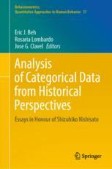Search
Search Results
-
Deconstructing Multiple Correspondence Analysis
This paper has two parts. In the first part we review the history of Multiple Correspondence Analysis (MCA) and Reciprocal Averaging Analysis (RAA)....
-
Correspondence Analysis with Pre-Specified Marginals and Goodman’s Marginal-Free Correspondence Analysis
Goodman (1996, JASA 91, 408–428) introduced marginal-free correspondence analysis where his principal aim was to reconcile Pearson’s correlation...
-
Variants of non-symmetric correspondence analysis for nominal and ordinal variables
Non-symmetric correspondence analysis (NSCA) is a multivariate data analysis technique that has gained increasing attention in recent years. NSCA is...

-
Sparse correspondence analysis for large contingency tables
We propose sparse variants of correspondence analysis (CA) for large contingency tables like documents-terms matrices used in text mining. By seeking...

-
Group and Time Differences in Repeatedly Measured Binary Symptom Indicators: Matched Correspondence Analysis
Examining group and time differences in binary indicators becomes complicated when two groups are repeatedly measured with interrelated binary...
-
Restricted Cumulative Correspondence Analysis
Amenta, Pietro D’Ambra, Antonello D’Ambra, LuigiIn the context of the non-iterative procedures for performing a correspondence analysis with linear...
-
What’s in a Name? Correspondence Analysis . . . Dual Scaling . . . Quantification Method III . . . Homogeneity Analysis . . .
This is an essay about nomenclature in statistics, in particular around the theme of dual scaling, a term invented by Shisuhiko Nishisato. The...
-
Generalised Canonical Correlation and Multiple Correspondence Analyses Reformulated as Matrix Factorisation
Generalised canonical correlation analysis (GCCA) is formulated as the least squares problem which can be called a homogeneity problem. The purpose...
-
Correspondence Analysis and Kriging: Projection of Quantitative Information on the Factorial Maps
In this study, a methodological scheme is proposed for the combined use of Analyse Factorielle des Correspondances—AFC (or Correspondence Analysis)...
-
Biplots for Variants of Correspondence Analysis
In the previous chapter, we gave an overview and application of biplots for numerical data. We described the three types of biplots that one may...
-
Confidence regions and other tools for an extension of correspondence analysis based on cumulative frequencies
Over the past 50 years, correspondence analysis (CA) has increasingly been used by data analysts to examine the association structure of categorical...

-
History of Homogeneity Analysis Based on Co-Citations
This contribution is a slightly edited text of a 14-page section of my non-digital Ph.D. thesis at Leiden University; see van Rijckevorsel (1987, pp....
-
Low Lexical Frequencies in Textual Data Analysis
The description of lexical tables (cross-tabulating vocabulary and texts) is commonly performed through correspondence analysis (CA) and is often...
-
PowerCA: A Fast Iterative Implementation of Correspondence Analysis
The visual exploration of big data requires interactivity as well as the possibility to update an existing solution as new data becomes available in...
-
Data Integration and Analysis
This chapter provides a wide variety of examples of the ways in which data can be manipulated using an item-based approach, demonstrating how to...
-
Five Strategies for Accommodating Overdispersion in Simple Correspondence Analysis
Traditionally, simple correspondence analysis applied to a two-way contingency table is performed by decomposing a matrix of standardised residuals...
-
Cluster Analysis
This chapter covers cluster analysis, a set of methods used for identifying groups of similar observations based on proximity measures. The chapter...
-
Information for Analysis
When we carry out data analysis, we encounter many kinds of data.
-
Correspondence Analysis
Correspondence analysis provides tools for analyzing the associations between rows and columns of contingency tables. A contingency table is a...
-
Analysis of Contingency Table by Two-Mode Two-Way Multidimensional Scaling with Bayesian Estimation
Visualisation methods for contingency tables, such as correspondence analysis and dual scaling, are widely used in many research fields. These...
